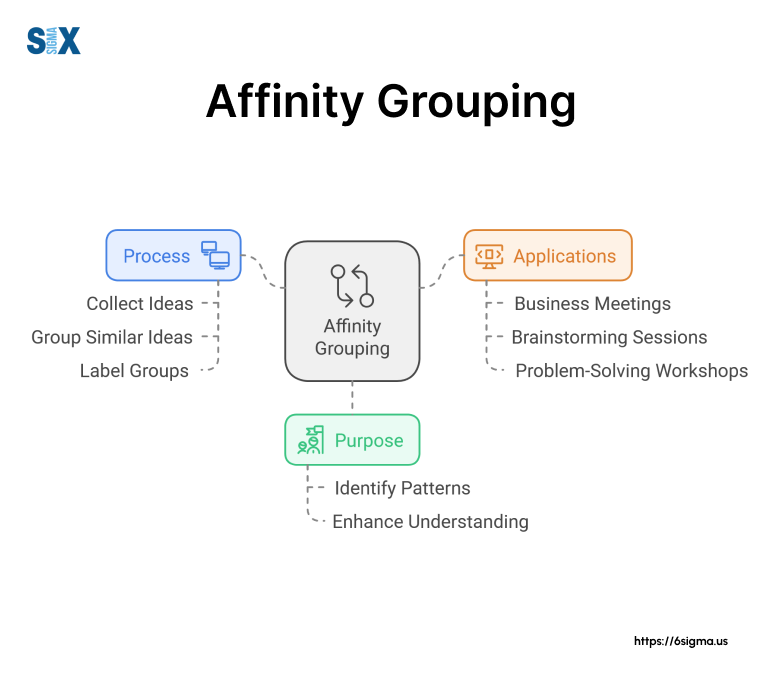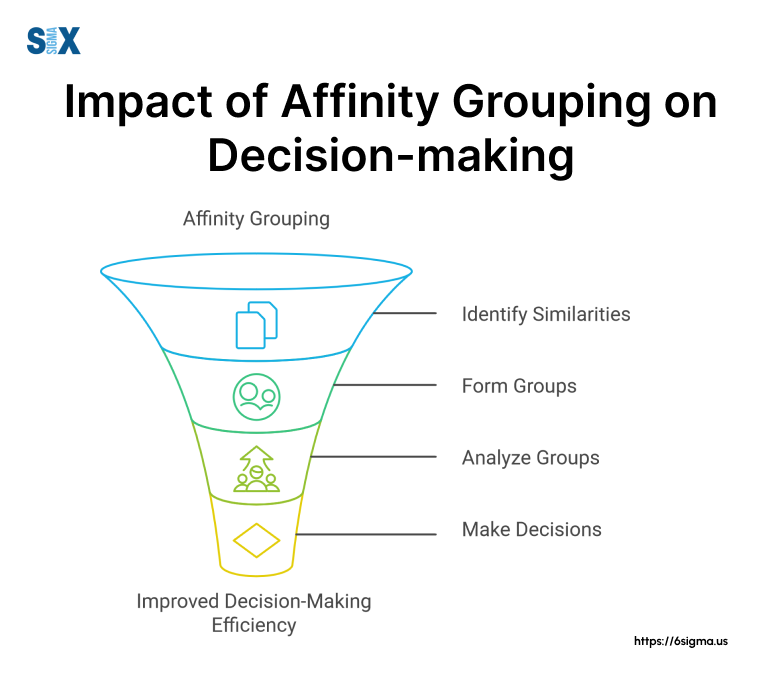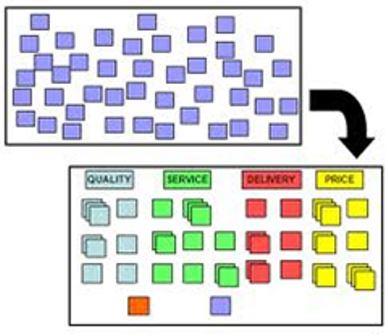Affinity Grouping: Boosting Productivity in Product Management
Imagine transforming a chaotic brainstorming session into a structured, actionable plan in just a few hours.
That’s the power of affinity grouping.
Where decisions need to be made quickly and effectively, mastering this technique can be a game-changer for product managers, UX researchers, business analysts, and team leaders alike.
Affinity grouping is more than just a buzzword; it’s a powerful tool that can streamline decision-making, prioritize features, and enhance team collaboration.
Key Highlights
- Definition
- Practical applications across various industries
- Effective affinity grouping sessions
- Discover best practices and common pitfalls
What is Affinity Grouping?
Affinity grouping, also known as affinity diagramming or the KJ method, is a powerful technique used to organize and analyze qualitative data.
We can describe it as a process of categorizing ideas, insights, or information into natural groups based on their relationships or similarities.
At its core, affinity grouping involves the following principles:
- Gathering diverse ideas or data points
- Identifying patterns and relationships among these elements
- Grouping similar items together
- Creating meaningful categories or themes
It emphasizes its role in transforming scattered information into structured, actionable insights.
This method is particularly useful when dealing with large amounts of qualitative data, such as customer feedback, brainstorming sessions, or user research findings.

Why Affinity Grouping Matters
Affinity grouping has become an indispensable tool for various reasons:
- Efficient Information Processing: It helps teams quickly make sense of complex, unstructured data.
- Enhanced Collaboration: The process encourages team participation and leverages collective intelligence.
- Improved Decision-Making: By organizing information into logical groups, it facilitates better decision-making and prioritization.
- Innovation Catalyst: It can reveal unexpected patterns and connections, sparking innovative ideas.
So, what is being accomplished by affinity grouping? Ultimately, it enables organizations to:
- Identify key themes and priorities
- Uncover hidden insights and opportunities
- Align team members around common goals
- Make data-driven decisions based on qualitative information
In product management and UX design, this is particularly valuable for:
- Analyzing user feedback and research data
- Prioritizing features and improvements
- Organizing and refining user stories
- Identifying user pain points and needs
By employing this, teams can transform overwhelming amounts of information into clear, actionable insights that drive product development and improve user experiences.
Get an Introduction to affinity grouping and its importance with Lean Six Sigma Yellow Belt
The Affinity Grouping Process: A Step-by-Step Guide
Understanding the affinity grouping process is crucial for effective implementation.
This comprehensive guide will walk you through each stage, from preparation to post-session activities, ensuring you can conduct successful sessions.
Preparing for an Affinity Grouping Session
Proper preparation is key to a successful affinity grouping analysis. Here’s what you need to do:
- Defining objectives and scope:
- Clearly articulate the problem or question you’re addressing
- Set specific, measurable goals for the session
- Determine the boundaries of ideas to be included
- Selecting participants and roles:
- Choose a diverse group of stakeholders with relevant expertise
- Assign a facilitator to guide the process and maintain focus
- Designate a note-taker for accurate documentation
- Gathering necessary materials and tools:
- Prepare sticky notes or index cards for idea generation
- Provide markers or pens for all participants
- Secure a large wall space or digital whiteboard for remote sessions
Conducting the Session
The heart of affinity grouping agile lies in the session itself. Follow these steps:
- Brainstorming and idea generation:
- Encourage participants to generate ideas freely without judgment
- Use prompts or questions to stimulate creative thinking
- Aim for quantity over quality at this initial stage
- Recording ideas on individual cards or notes:
- Write each idea on a separate card or sticky note
- Keep ideas concise and clear, using 3-7 words if possible
- Ensure all ideas are visible to the entire group
- Grouping similar ideas together:
- Silently arrange cards with similar themes or concepts
- Allow for organic grouping without discussion at first
- Create new groups as needed, avoiding forced categorization
- Creating headers for each group:
- Collaboratively develop descriptive headers for each cluster
- Ensure headers accurately represent the group’s content
- Refine headers as needed for clarity and precision
- Discussing and refining groups:
- Review and discuss each group as a team
- Make adjustments based on group consensus
- Identify any outliers or unique ideas that don’t fit existing groups
Want to conduct one? Here is your detailed guide on conducting affinity grouping sessions with Lean Six Sigma Green Belt
Post-Session Activities
After the main session, crucial steps remain to maximize the value of your affinity grouping analysis:
- Documenting results:
- Capture all groups and their contents in detail
- Take photos or screenshots of the final arrangement
- Create a digital record for easy reference and sharing
- Prioritizing groups:
- Use voting or ranking techniques to prioritize groups
- Consider impact, feasibility, and alignment with objectives
- Identify top priority groups for immediate action
- Creating action plans:
- Use voting or ranking techniques to prioritize groups
- Consider impact, feasibility, and alignment with objectives
- Identify top priority groups for immediate action
Best Practices and Common Pitfalls
To ensure the effectiveness of your affinity grouping sessions:
Tips for effective facilitation:
- Maintain a neutral stance to avoid influencing outcomes
- Encourage equal participation from all team members
- Keep the session focused and on-track, managing time effectively
Avoiding biases and groupthink:
- Challenge assumptions and encourage diverse perspectives
- Use anonymous idea submission when appropriate to reduce social influence
- Rotate group leaders or facilitators to prevent dominance by one viewpoint
By following this guide, you’ll be well-equipped to conduct effective affinity grouping analysis in various contexts, including agile environments.
Remember, the key to successful affinity grouping is maintaining an open mind and fostering a collaborative atmosphere.
With practice, you’ll find that this technique becomes an invaluable tool in your problem-solving and decision-making toolkit.
Advanced Affinity Grouping Techniques
As organizations become more sophisticated in their use of affinity grouping, advanced techniques have emerged to enhance its effectiveness and applicability in complex scenarios.
These advanced methods push the boundaries of traditional affinity grouping, allowing for more nuanced and powerful analyses.
Large-Scale Affinity Grouping Sessions
When dealing with extensive projects or large teams, traditional methods may fall short. Advanced techniques for managing large-scale sessions include:
Breakout sessions can be employed, where smaller teams work on specific aspects of the problem before coming together for a unified analysis.
This approach maintains engagement and ensures all voices are heard.
Virtual whiteboard tools like Miro or MURAL enable teams to conduct affinity grouping sessions remotely.
These platforms offer features like infinite canvases, real-time collaboration, and digital sticky notes, making large-scale remote sessions not only possible but highly effective.
Integrating Quantitative Data
Advanced affinity grouping analysis often incorporates quantitative data to provide a more comprehensive view:
By integrating numerical data into the grouping process, teams can validate qualitative insights with hard numbers. For instance, user feedback can be weighted based on user engagement metrics or revenue impact.
Not all ideas or insights carry equal importance.
Weighted voting allows team members to assign relative importance to different groups or ideas, ensuring that the most critical issues receive appropriate attention.
AI and Machine Learning Applications
Artificial intelligence and machine learning are revolutionizing affinity grouping:
Automated grouping algorithms: AI-powered tools can analyze large datasets and suggest initial groupings, significantly speeding up the process. Human experts can then refine these machine-generated groups.
Natural language processing for idea clustering: Advanced NLP algorithms can analyze text-based data (like customer feedback or survey responses) and automatically cluster similar ideas, providing a starting point for human analysis.
Cultural Considerations in Global Teams
As businesses become increasingly global, affinity grouping must adapt to diverse cultural contexts:
Adapting the process for diverse groups: Consider cultural differences in communication styles and decision-making processes.
Some cultures may prefer more hierarchical structures, while others thrive in flat, collaborative environments.
Overcoming language barriers: Utilize real-time translation tools to ensure all team members can contribute equally. Consider using visual aids and symbols that transcend language to represent ideas.
These advanced techniques demonstrate its evolving nature.
By embracing these methods, organizations can tackle more complex problems, involve larger and more diverse teams, and derive deeper, more actionable insights from their data.
As affinity grouping continues to evolve, it remains a crucial tool for decision-making and innovation across industries.
Here’s an interactive tool comparison table that highlights the key differences between Affinity Grouping and the other prioritization techniques discussed:
| Feature | Affinity Grouping | MoSCoW Method | Kano Model | Story Mapping |
|---|---|---|---|---|
| Primary Purpose | Organize and categorize ideas | Prioritize requirements | Analyze customer satisfaction | Visualize user journey and features |
| Flexibility | High | Medium | Medium | High |
| Structure | Emergent categories | Predefined categories | Predefined categories | User-journey based |
| Best for | Organizing diverse ideas | Quick prioritization | Product feature analysis | Product backlog creation |
| Team Collaboration | High | Medium | Low | High |
| Time Investment | Medium to High | Low | Medium | High |
| Output | Grouped ideas and insights | Prioritized list | Feature satisfaction matrix | Visual product roadmap |
This interactive table allows readers to quickly compare the key attributes of each prioritization technique, helping them understand when and how to use each method effectively in their projects.

The Future of Affinity Grouping
As technology continues to evolve and organizations seek more sophisticated ways to analyze and organize information, the future of affinity grouping looks promising and exciting.
Emerging Trends
Virtual and augmented reality technologies are opening up new possibilities.
Imagine conducting an affinity grouping session in a virtual 3D space, where team members can manipulate and organize ideas using gesture controls.
This immersive experience could enhance collaboration and provide new ways to visualize complex relationships between ideas.
AI-Powered Real-Time Grouping and Analysis:
Artificial Intelligence is revolutionizing this analysis.
Advanced algorithms can now process vast amounts of data in real-time, suggesting groupings and insights as ideas are being generated.
This AI assistance can help teams identify patterns more quickly and efficiently, allowing for more dynamic and responsive affinity grouping sessions.
Potential Developments
The future may see the emergence of predictive affinity grouping, where AI models can anticipate potential groupings based on historical data and current trends.
This could be particularly useful in agile environments, helping teams proactively identify and address emerging issues or opportunities.
Cross-Disciplinary Applications:
As the power of affinity grouping becomes more widely recognized, we may see its application expand into new fields.
For example, it could be used in scientific research to identify unexpected connections between different studies or in public policy to analyze complex societal issues from multiple perspectives.
These advancements promise to enhance what is being accomplished, making it an even more powerful tool for organizing information, generating insights, and driving innovation across various disciplines.
Conclusion
Affinity grouping stands as a powerful and versatile tool in the modern business landscape.
Throughout this article, we’ve explored the its definition, its applications across various industries, and the evolving techniques that continue to enhance its effectiveness.
From product management to agile development, the benefits of this method are clear and far-reaching.
What is being accomplished by affinity grouping?
At its core, it’s a systematic approach to organizing complex information, uncovering hidden patterns, and driving informed decision-making.
As we’ve seen, it is not just a static concept but a dynamic methodology that continues to evolve with technological advancements.
From AI-assisted grouping to virtual reality applications, the future of affinity grouping promises even greater potential for innovation and insight generation.
We encourage you to implement affinity grouping in your next project.
Whether you’re a product manager refining your roadmap, a UX researcher analyzing user feedback, or a business strategist tackling complex market dynamics, affinity grouping can provide valuable structure and clarity to your process.
Remember, the power lies not just in the methodology, but in its ability to bring teams together, align perspectives, and uncover insights that drive meaningful action.
Embrace this technique, and unlock new levels of creativity and efficiency in your projects.
SixSigma.us offers both Live Virtual classes as well as Online Self-Paced training. Most option includes access to the same great Master Black Belt instructors that teach our World Class in-person sessions. Sign-up today!
Virtual Classroom Training Programs Self-Paced Online Training Programs








